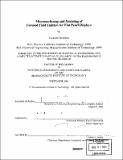| dc.contributor.advisor | Akintunde Ibitayo (Tayo) Akinwande. | en_US |
| dc.contributor.author | Dvorson, Leonard, 1974- | en_US |
| dc.contributor.other | Massachusetts Institute of Technology. Dept. of Electrical Engineering and Computer Science. | en_US |
| dc.date.accessioned | 2005-08-23T18:21:51Z | |
| dc.date.available | 2005-08-23T18:21:51Z | |
| dc.date.issued | 2001 | en_US |
| dc.identifier.uri | http://hdl.handle.net/1721.1/8215 | |
| dc.description | Thesis (Ph. D.)--Massachusetts Institute of Technology, Dept. of Electrical Engineering and Computer Science, 2001. | en_US |
| dc.description | "September 2001." | en_US |
| dc.description | Includes bibliographical references (p. 120-126). | en_US |
| dc.description.abstract | We present a comprehensive study of field emitter arrays with or without an integrated focus electrode. The former configuration is referred to as field emitter with integrated focus (IFE-FEA) or double-gate FEA (DG-FEA). The main application of IFE-FEA is to improve the resolution of field emission displays (FEDs). We developed the first analytical model of conical field emitters that captures all details of device geometry and produces quantitatively accurate closed-form expressions for the FN coefficients. A novel CMP-based process for making IFE-FEA is presented. We obtained devices with gate and focus apertures of 0.8 and 1.2 gm diameter, respectively, which is 1.5 times smaller than in any previously reported IFE-FEA. Single-gate FEAs whose gate was identical to the lower gate of the IFE-FEA were also fabricated. Their emission current was 100 nA/tip at 45 V; for IFE-FEAs with the gate and focus biased at the same potential (VG=VF) this figure was 100 nA/tip at 42 V, in agreement with the analytical model. It was deduced that the tip radius of curvature (ROC) is 2.4-3.6 nm. Analytical model, numerical simulation, and TEM micrographs all gave tip ROC values in this range. We generalized the FN equation to IFE-FEA and used 4-terminal measurements to determine gate and focus field factors, [3G and 13F. Their ratio was found to vary from 0.15 (emission current independent of focus voltage) to 2.7. We demonstrated via numerical simulation that this ratio is probably determined by the degree of gate shielding of the tip. | en_US |
| dc.description.abstract | (cont.) We studied electron beam collimation with lowering VF at different values of VG. It was observed that the optimal VF is about 0.25VG. Beam collimation was also studied as a function of cathode-anode separation - a novel experiment. From these measurements we deduced horizontal velocity of electrons and determined that it is practically equal to zero when the beam is optimally collimated. Under optimal collimation, diameter of the spot size produced by a 5x5 array with a 40x40 ptm2 footprint on the phosphor screen biased at 5kV and located 15 mm away was at most 50 tm. | en_US |
| dc.description.statementofresponsibility | by Leonard Dvorson. | en_US |
| dc.format.extent | 126 p. | en_US |
| dc.format.extent | 14751170 bytes | |
| dc.format.extent | 14750927 bytes | |
| dc.format.mimetype | application/pdf | |
| dc.format.mimetype | application/pdf | |
| dc.language.iso | eng | en_US |
| dc.publisher | Massachusetts Institute of Technology | en_US |
| dc.rights | M.I.T. theses are protected by copyright. They may be viewed from this source for any purpose, but reproduction or distribution in any format is prohibited without written permission. See provided URL for inquiries about permission. | en_US |
| dc.rights.uri | http://dspace.mit.edu/handle/1721.1/7582 | |
| dc.subject | Electrical Engineering and Computer Science. | en_US |
| dc.title | Micromachining and modeling of focused field emitters for flat panel displays | en_US |
| dc.type | Thesis | en_US |
| dc.description.degree | Ph.D. | en_US |
| dc.contributor.department | Massachusetts Institute of Technology. Department of Electrical Engineering and Computer Science | |
| dc.identifier.oclc | 50121360 | en_US |

